 Smooth Sailing
Smooth SailingA Taste for Easy Coastal Fare
From the Outer Banks of North Carolina down to the French Quarter of New Orleans and up to the sidewalks of New York City, it’s seafood season. In your Triangle home, you don’t have to choose between high-end fancy fish preparations and low-end freezer fish sticks because these recent cookbooks feature accessible recipes that cruise from the high seas to your plate.
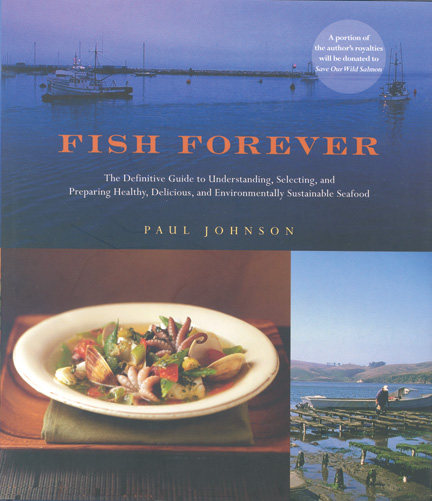 Fish Forever
Fish Forever
by Paul Johnson
Published by John Wiley & Sons
Charcoal-Grilled Wild King Salmon
With Cherry Tomato-Basil Relish
The flavor of fresh wild salmon grilled over charcoal, the tang of cherry tomatoes, and the aroma of fresh basil are incomparable. If I could make every recipe in this book as simple and tasty as this, I would. It’s nothing but simple, fresh ingredients that complement one another perfectly.
Serve with corn on the cob and green salad. The relish is great on the corn and as a dressing for the salad as well.
Four 6-ounce wild king salmon fillets or steaks
Sea salt and freshly ground pepper to taste
Olive oil
Cherry Tomato-Basil Relish (see recipe below)
Prepare a hot fire in a charcoal grill. Season the fish with sea salt and freshly ground pepper. Oil the grill rack well and lightly brush the fish with oil. Grill the fish, turning halfway through the cooking process, for a total of 8 to 10 minutes per inch of thickness, or until slightly charred on the edges and still slightly translucent in the center. Serve with Cherry Tomato-Basil Relish alongside.
Makes 4 servings.Cherry Tomato-Basil Relish
Cherry tomatoes are usually more sharply acidic than many of today’s tomatoes, a good thing in my mind. A little balsamic vinegar, olive oil, fragrant basil leaves and a sprinkling of salt are all that’s needed to balance their flavor. Use only the best-quality oil and vinegar.
1 basket cherry tomatoes
1 garlic clove
1 teaspoon coarse sea salt
1 tablespoon balsamic vinegar
1/4 cup olive oil
1 cup firmly packed fresh basil leaves, coarsely chopped
Cut the cherry tomatoes in half if they’re small or in quarters if they’re large. In a wooden bowl, mash the garlic and salt to a paste with a pestle, then stir in the vinegar. Whisk in the oil, then add the tomatoes and basil, gently tossing everything together. Serve immediately.
Makes 2 cups.
 The Outer Banks Cookbook
The Outer Banks Cookbook
Recipes and Traditions From
North Carolina’s Barrier Islands
by Elizabeth Wiegand
Published by Morris Book Publishing
Traditional Outer Banks Crab Cakes
At the Pony Island Restaurant on Ocracoke, Vince O’Neal makes these crab cakes daily. It’s a recipe passed down through several generations of his family.
His ancestor was the first pilot who established himself in the tiny port, back when it was the only navigable inlet around before Hatteras Inlet opened during two storms. Because Ocracoke’s inlet would shift and shoal much as it still does today, it was treacherous to bring in cargo ships. So local men, pilots, would guide the larger vessels in from the ocean to the port.
Vince’s great-great-aunt was another local legend, the only midwife on the island for years, who delivered babies well into her 80s.
Full of crabmeat, with very little breading, these crab cakes are seasoned in traditional Outer Banks style with dry mustard and Worcestershire sauce. They’re usually served with crispy coleslaw and hushpuppies at the Pony Island Restaurant.
I find that crab cakes hold together better if you refrigerate the formed cakes before frying.
1 pound claw crabmeat1 pound backfin crabmeat
1/3 cup fine bread crumbs
2 teaspoons dry mustard
2 tablespoons mayonnaise
1-1/2 tablespoons Worcestershire sauce
2 eggs
1 teaspoon dried parsley flakes
1/2 teaspoon Old Bay seasoning
Vegetable oil for frying
Place crabmeat in a large bowl, picking through it and carefully removing any remaining shell or cartilage without breaking up any lumps of crabmeat.
Sprinkle the bread crumbs over the crabmeat.In a small bowl, whisk together the mustard, mayonnaise, Worcestershire sauce, eggs, parsley flakes and Old Bay.
Gently fold the mayonnaise mixture into the crabmeat. Shape by hand into patties about 3 inches wide. Refrigerate for at least 30 minutes, up to 4 hours.
Heat about 1/4 inch oil in an electric frying pan to 350 degrees (or on medium-high heat on stovetop). Fry crab cakes until golden brown on both sides. Serve immediately.
Makes 6 servings (two crab cakes per serving).
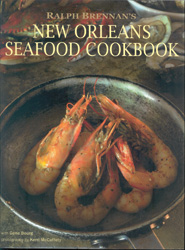 Ralph Brennan’s New Orleans Seafood Cookbook
Ralph Brennan’s New Orleans Seafood Cookbook
by Ralph Brennan with Gene Bourg
Published by Vissi d’Arte Books
Creole Jambalaya
This rice dish is one of the oldest in the traditional New Orleans Creole cook’s repertoire. It shares characteristics with Spanish paëllas, but it has even stronger connections with traditional African rice cookery.
Some have speculated that “jambalaya” is a contraction of “jambon à la ya-ya” – marrying the French word “jambon,” for “ham,” with the old African Bantu word “ya-ya,” for “rice.”
Over the decades, jambalaya has taken on a multitude of identities in South Louisiana. The classic New Orleans dish with shrimp and ham is among the “red” jambalayas, thanks to the presence of tomatoes in it. In many of the Cajun communities to the west of the city, “brown” jambalayas, with oysters, giblets and lusty country sausages, are more familiar.
In present-day New Orleans homes, jambalaya’s easy preparation makes it popular party fare, especially during such local celebrations as Mardi Gras and the New Orleans Jazz & Heritage Festival.
1 tablespoon unsalted butter (or 2 tablespoons if the pork and sausage are very lean)
4 ounces andouille sausage (may substitute smoked or Polish sausage or kielbasa), sliced into 1/4-inch rounds
4 ounces pickled pork (a seasoning meat used to add flavor to greens, beans and other “pot food” in the Deep South) or ham, cut into 1/4-inch cubes
1 medium-size yellow onion, chopped
1 bunch of green onions, chopped, with white and green parts separated
1 medium-size green sweet pepper, chopped
2 cans (10 ounces each) crushed plum tomatoes 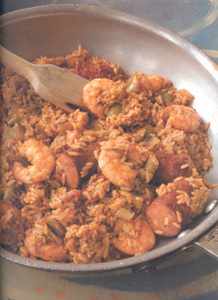
1/4 cup canned tomato purée
2 cloves garlic, minced
1 whole bay leaf
1 teaspoon table salt
1/2 teaspoon ground black pepper
1/4 teaspoon ground cayenne
1/4 teaspoon dry thyme leaves
4 quarts chicken stock
1 tablespoon Louisiana pepper sauce
2 cups long-grain white rice, uncooked
1 pound raw medium shrimp, peeled
Over medium-high heat, melt the butter in a heavy, nonreactive 6-quart saucepan or Dutch oven.
Add the sausage and pickled pork or ham and cook until all of the fat is rendered out of the meats, about five minutes, stirring occasionally.
Add the yellow onions, the white part of the green onions and the sweet peppers. Cook the vegetables until they are clear, about five minutes, occasionally stirring and scraping the pan bottom clean.
Add the crushed tomatoes, tomato purée, garlic, bay leaf, table salt, black pepper, cayenne and thyme. Cook and stir this base sauce about two minutes. (If the dish is being prepared ahead, allow the base sauce to cool, then place in a lidded nonreactive container and store it in the refrigerator for up to two days. For the final preparation, heat the base to a boil and proceed with the remainder of the recipe.)
Add the chicken stock and pepper sauce to the base and bring to a boil.
Reduce the heat to maintain a strong simmer, and simmer the liquid uncovered until it is reduced by one third, about 1 hour 15 minutes. Skim any foam or coagulates as they develop on the surface.
Return the liquid to a boil and stir in the rice.
Reduce the heat to medium, and cook uncovered until the rice is just short of being done (it should still be a little firm in the center), about 25 minutes, stirring occasionally.
Add the shrimp and cook until the rice is tender and the shrimp turn bright pink, about three minutes. Do not overcook.
Stir in the green part of the green onions.
Makes 6 servings.
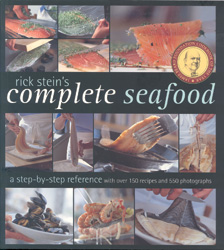 Rick Stein’s Complete Seafood
Rick Stein’s Complete Seafood
by Rick Stein
Published by Ten Speed Press
Grilled Snapper With a Mango, Shrimp and Chile Salsa
Four 6-ounce pieces of unskinned snapper fillet (alternative fish options are red mullet, sea bass, bream or porgy, john dory, and gray or striped mullet)
Extra virgin olive oil
Salt and freshly ground black pepper
Cilantro sprigs, for garnish
Salsa:
2 large, medium-hot red chile peppers
4 ounces peeled, cooked tiger shrimp, thickly sliced
4 green onions, thinly sliced
1 small garlic clove, minced
1 ripe but firm avocado, peeled and cut into small dice
1/2 ripe but firm mango, peeled and cut into small dice
Juice of 1 lime
Pinch of salt
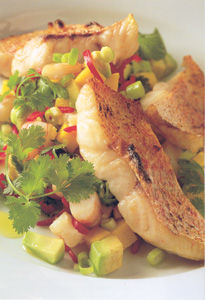 If you are using a charcoal grill, prepare and light it 30 to 40 minutes before you want to cook the fish.
If you are using a charcoal grill, prepare and light it 30 to 40 minutes before you want to cook the fish.
For the salsa, cut the chiles in half lengthwise and scrape out the seeds with the tip of a small knife; leave the ribs behind to give the salsa a little more heat. Cut the chiles across into thin slices. Then simply mix all the salsa ingredients together.
If you are not cooking the fish over charcoal, put a ridged cast-iron grill pan over a high heat (or preheat the broiler). Brush the snapper fillets on both sides with olive oil and season well with salt and pepper. Cut each one into three, slightly on the diagonal.
Cook the pieces of snapper, either skin-side down on the grill or grill pan or skin-side up under the broiler, for 3 to 4 minutes.
To serve, spoon the salsa onto four plates and arrange the grilled strips of fish on top. Drizzle a little oil around the edge of the plates and garnish with cilantro sprigs.
Makes 4 servings.

The Young Man & the Sea
Recipes & Crispy Fish Tales From Esca
by David Pasternack & Ed Livine
Published by Artisan
Mussels in the Style of Livorno
Livorno is a coastal town in southern Tuscany that has great olives and olive oil. I’ve spent a fair amount of time there and in the adjoining Cinque Terre, a series of connected seaside towns most easily navigated on foot. Cooks there prepare many dishes with capers, black olives, and tomato in some form (either fresh or sauce), so that’s what I use here. The mussels we find in this country are all farm-raised, so they’ve been cleaned and washed for us. Just make sure they’re closed when you buy them. This dish is really easy, quick, and delicious. Serve it with a loaf of crusty bread to soak up the sauce.
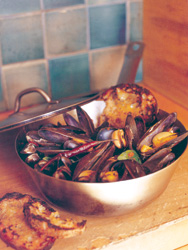 3 tablespoons extra-virgin olive oil
3 tablespoons extra-virgin olive oil
2 cloves garlic, roughly chopped
2 whole peperoncino (sweet Italian peppers)
3 tablespoons capers (preferably salt-packed), rinsed
1/4 cup pitted Gaeta olives (if necessary, substitute Kalamata or another flavorful, dark olive)
1 cup tomato sauce
Fresh ground black pepper
1 pound mussles
2 tablespoons roughly chopped basil leaves
2 tablespoons roughly chopped flat-leaf parsley
In a saucepan with a tight-fitting lid, heat the olive oil over a medium flame for about 1 minute. Add the garlic, peperoncino, capers and olives. Cook for about 4 minutes, until the garlic has softened and the peperoncino is tender.
Add the tomato sauce, season with pepper, stir to blend, then add the mussels. Cover and cook until the shells open (discard those that don't), about 2 minutes.
Remove the pot from the stove. Add the basil and parsley, and stir gently to combine. Divide the mussels among four serving bowls, being sure to include some of the sauce in each dish.
Makes 4 servings.

